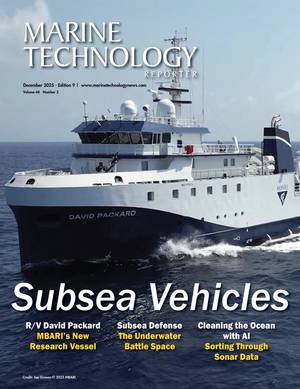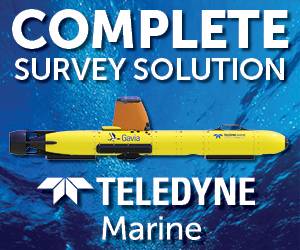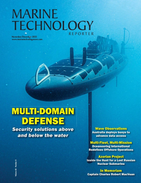Autonomous Underwater Vehicles
Autonomous underwater vehicles are robots using a propulsion system in order to navigate undersea and they do not require a human occupant; instead, they are controlled by an onboard computer system and can move in all three directions. Despite any challenges of the environments, AUVs can successfully follow their set trajectories without problem. They feature a variety of sensors that enable them to move through the ocean, and to make any kinds of measurements. In order to collect proper temporal and special sampling, sending in a team of autonomous underwater vehicles is more efficient than sending a single one. This way, they can investigate their objective more coherently. AUVs can be programmed to float passively through water, keep a certain straight trajectory for a preset amount of time or simply travel at a constant pressure. They can support acoustic or optical underwater imaging technologies in order to serve particular goals. They can stay undersea for as long as 50 hours without requiring refueling. Many autonomous underwater vehicles are able to vary their velocity between 0.5 and 2.5 m/s. They function at their optimum ability regarding speed and range when its hotel load is twice the propulsive load, at the velocity of 1.5 m/s. Even though they can function completely autonomously, full autonomy does not enable proper information on the vehicle’s state or progress, nor does it allow sudden changes in direction during missions. Anyway, autonomy allows the operator to perform other urgent tasks, so it is time-saving, which is a greatly appreciated capacity in some missions. During routine checks, complete autonomy is preferable. Autonomous undersea vehicles can be monitored and redirected thanks to the bidirectional acoustic, satellite communications and radio frequency systems and because of this, semi-autonomous operations offer a great advantage over the ones with full autonomy. History of Autonomous Underwater Vehicles Origins. The history of AUVs can be traced back to the “Fish” Torpedo, modeled, built and operated by Robert Whitehead in 1866. The name of the machine is linked to the electric fish that kills its prey with a powerful shock. The first torpedo was able to reach a speed of 3 m/s and run for almost 700 meters. It moved with compressed air and was used to carry explosives. Pioneers. Bob Francois and then Terry Ewart at the University of Washington continued the research on AUVs in the 50’s, pressed by the need to obtain pertinent and precise oceanographic data under ice. This is how the first “real” AUV was born. It was named The Self Propelled Underwater Research Vehicle(s) (SPURV). The first version of this vehicle, SPURV I, was the prototype that supported the research in the 70’s. It weighted 480 kilograms, had a speed of 2.2 m/s, and could last more than 5 hours at 3 kilometers undersea. Operators were able to control it acoustically from aboard a vessel. The Naval Ocean System Center, now SPAWAR, began development of the Advanced Unmanned Search System (AUSS) in 1973 in response to the sinking of the USS Thresher, the USS Scorpion, and the H bomb loss of Palomares. The vehicle was launched in 1983, and reports and publications on the system were still in press in the 90’s. AUSS displaced 907 kg, carried 20 kw-hours of energy in silver zinc batteries, and was rated to 6 km. It had an acoustic communication system that transmitted video images through the water. AUSS completed over 114 dives, some to 6 km. The concept of using multiple free swimming vehicles to improve system performance can be traced to the development of this system. This work was completed some time in the early 80’s. The first autonomous underwater vehicle that could support deepsea photography and survey technology was Epulard, created in 1980. Other six prototypes of AUVs were created by 1987. Back then, AUVs were still called untethered ROVs. In the early 90’s, the Autonomous Benthic Explorer (ABE) was developed. It was sent in its first mission in 1994; it had 680 kg and could stay underwater for 34 hours, 5 km deep. It was highly maneuverable in all directions and was mainly used for seafloor surveys in rough terrain. Other autonomous underwater vehicles developed in the 90’s were Theseus, created by the International Submarines Engineering, for defense purposes. It had 8,600 kg, a maximum speed of 2 m/s and could operate for 100 hours at 1 km depth. The REMUS AUV was funded by NSF and NOAA in scientific purposes. It had 36 kg and could operate for 20 hours at a depth of 100 m, moving with 1.5 m/s. Its longest mission lasted for 17 hours. Autosub was developed by the South Hampton Oceanography Center, also in scientific purposes. It has 1,700 kg, could stay underwater for 6 days, travel at 3 knots at a 1.6 km depth. The new century technology stressed mainly the deepsea research. To this purpose, many new types of AUVs were created, among which Hugin 3000 was produced by Kongsberg Simrad in Norway, to provide survey services. It had 1,400 kg, could move at 4 knots for 40 hours. Trends in AUV Production Many autonomous underwater vehicles today are created for commercial and scientific purposes. For an AUV to be competitive, it needs to address several aspects – it must be easy to operate and reliable, made of quality materials and featuring the latest technology; it must provide a complete solution for its assigned missions; it must feature a large range of sensor systems; it should be operated from many types of ships; its system should be easy to launch and recover. Most of all, it must be able to pass on information to another AUV in its team, using an acoustic link, so that the second vehicle can readjust its mission. Autonomous underwater vehicles can be used in all domains. They have commercial applications (especially in the oil and gas industry), they are used in military missions, in anti-mine and anti-submarine warfare, by researchers, in their study of the ocean environment and by passionate amateurs.

Schmidt Ocean Institute Advances R/V Falkor (too)’s Mapping Capabilities
Schmidt Ocean Institute announced it has mapped two million square kilometers of…

MOG, HHI Ink MoU to Build Submarines
Maritime Operations Group (MOG) and HD Hyundai Heavy Industries (HHI) signed a memorandum…

Saipem Gets DNV Certification for Offshore Asset Lifecycle Management
Saipem has obtained ISO 55001:2024 certification, the international standard for…

2025: Fascinated with Subsea Discovery
Our fascination with the depths of the ocean revealed itself in some of our most…

USV Surveys to Aid Restoration Efforts on Scottish Loch
Restoration efforts on a Scottish loch have been boosted by experimental techniques…

In Memoriam: Captain Charles Robert MacVean, USN, (Ret.), PhD
The book, Blind Man’s Bluff, describes the secret USN submarine operations known…

Fugro Nets Mubadala Energy’s Deepwater Gas Job in Asia
Fugro has secured a large contract with Mubadala Energy to deliver advanced soil…

Battery Power Management and Control
The management of DC power is one of the basic challenges in designing an autonomous ocean lander.

The Impact of AI Traffic on Subsea Fiber Networks
Fiber optic networks provide the connectivity ubiquitous to modern society, enabling…

Mads Nipper Appointed as Chair of MacArtney Underwater Technology Board
MacArtney Underwater Technology has appointed Mads Nipper as Chair of the Board.

Ukraine Says Underwater Drones Hit Submarine, Russia Denies Damage
Ukraine said on Monday it hit and disabled a Russian missile-carrying submarine docked…

Thales Introduces New Sonar 76Nano for the Underwater Battle Space
Thales has introduced the prototype of Sonar 76Nano, a miniaturized acoustic detection…
The Social Media Landing Page for Marine Technology Reporter

To celebrate Oceanology International’s 50th anniversary, Oceanology International will collaborate with Marine Technology Reporter to produce a commemorative edition in celebration of 50 years of Oceanology International.
The seas and oceans have always represented one of the greatest challenges for the human kind. Nowadays, almost all countries admit the decisive role of oceans in climate and land systems, the importance of coasts, seas and oceans and their ecosystems for human health and welfare.
Planning the exploitation of offshore oil and gas fieldsWhen oil and gas fields are uncovered and they seem to be profitable investments, companies need to figure out the best means to extract these resources. The planning must be carefully…
Now is your chance to reach an extraordinary audience with the Oceanology International Americas 50th Anniversary edition.













 December 2025
December 2025


